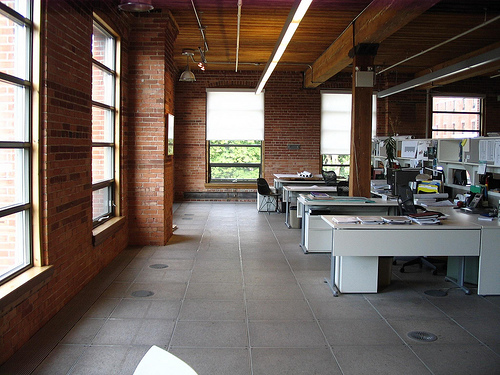Is corporate America closing the door on open offices?
It used to be the case that office layouts fell into one of two categories:
- Cubicle-land, à la Office Space, or
- Secretaries and underlings in the middle, bigwigs behind closed doors around the perimeter, à la Mad Men
Then, in the mid-2000s, open offices became all the rage. Companies tore down walls and burned up cubicles (perhaps not literally, though I’m sure many erstwhile cubicle-dwelling employees dreamed of setting a match or two).

Some workers look at open offices and see freedom from the tyranny of the cubicle; others are just reminded of Sartre’s dictum that “hell is other people.” Image from Loozrboy.
At first, the trend toward open offices was largely limited to operations that were, either in thinking and/or in practice, artsy. By 2008, open offices were commonplace.
The over-arching mission behind open offices: Facilitate collaboration. Encourage transparency. Get stuff done. Some particularly even brought in cafeteria tables in lieu of desks in an effort to truly present a “team effort” ambiance.
The good news: Open offices are cheaper to construct, assuming you don’t have to spend a lot of money demoing your existing space. They also conserve space, since you can fit more people into a room that isn’t segmented into offices or cubicles.
The problem: Open offices are noisy. And distracting. The same employees who were desperate to break free of cubicles often felt over-exposed and under-focused after moving to an open plan layout.
By 2011, the open-office backlash had already begun. As reported in The New Yorker, organizational psychologist Matthew Davis studied office environment and found that open office spaces, while fostering “a symbolic sense of organizational mission,” were also “damaging to the workers’ attention spans, productivity, creative thinking, and satisfaction.”
Interestingly, Davis also found that the more senior an employee was at his or her organization, the worse he or she fared when plunged into an open office layout. (So it turns out that there might be some logic behind that “corner office with a view for the CEO” strategy, after all.)
So what are company leaders to do? If your organization has already embraced the open office trend, do you go back to the way things were, thereby theoretically improving employee focus and satisfaction but eliminating the sense of camaraderie that the open plan facilitated? Or do you stick with the open plan, knowing that everyone’s going to be less happy and less productive?
If you’re one of an increasing number of companies thinking outside the cubicle and beyond the cafeteria table, you’re turning to something different entirely.
At IBM’s software development center in Austin, Texas, everything in the office is movable—including the walls. Mobile walls make it possible for employees to construct whatever version of office plan layout suits the day’s tasks: open spaces for meetings and brainstorming sessions, and closed off spaces for focused, independent work.
Writer Michael Ortner of The Next Web is actually a fan of the open office concept, but says it has to be done correctly, with accommodations for the noise, lack of privacy, and prevalent distractions inherent in that type of layout. One operation that has Ortner’s seal of approval: Facebook. Their headquarters has lots of open space, but they also built a library right in the headquarters building so employees always have some place to escape to for privacy, quiet, and fewer distractions.
Slate reports that LinkedIn uses adjustable-height workstations throughout their headquarters, and while those workstations are clustered together, there are plenty of places for employees to get away—including a replica speakeasy (yes, you read that correctly). To enter the speakeasy, employees have to “pick up and hang up one of the 133 phones [hanging on the wall] to unlock the door.” Now that’s an escape.
Ariel Schwartz of Fast Company’s CoExist interviewed Primo Oprilla, a principal designer at an interior design firm in San Francisco called O+A. Orpilla says that, if companies are disillusioned with their open offices but don’t want to go all the way back to the way things were, they should “have lots of variety and don’t cram too many people into a small space.”










